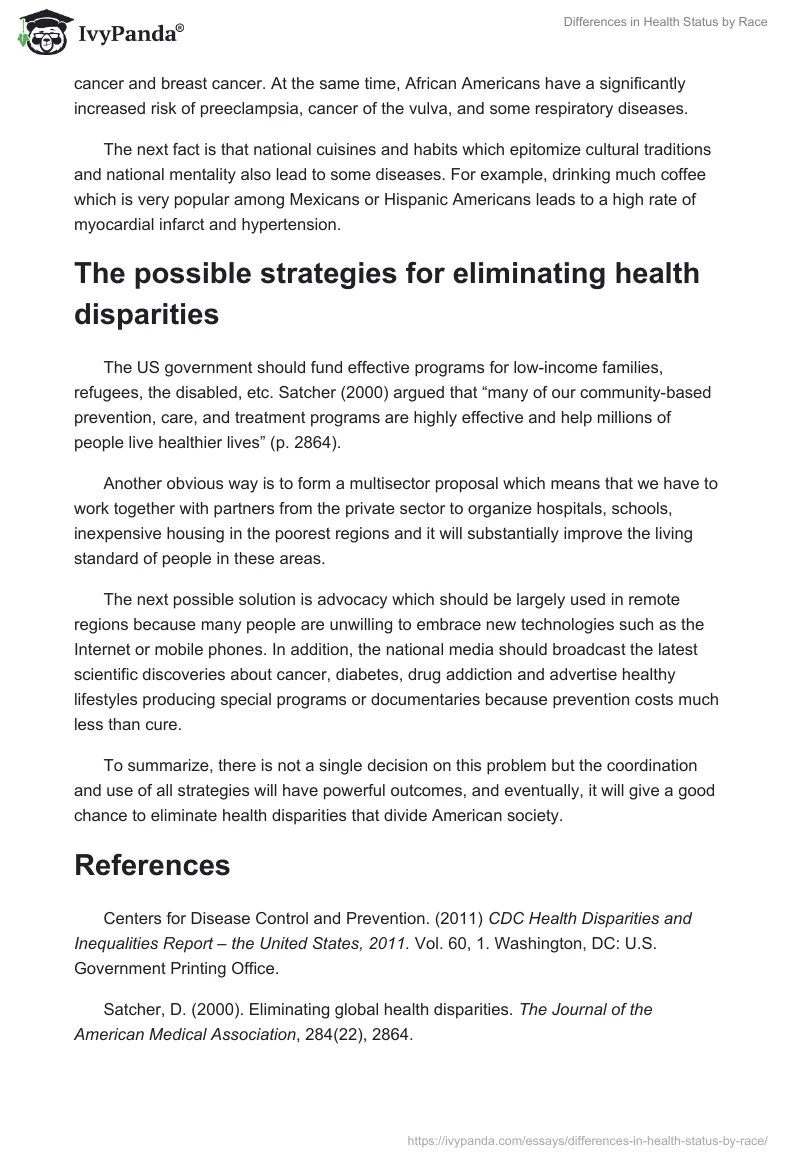Health disparities are defined as the dissimilarity between groups of people in terms of disproportion in health status, the spread of various diseases, and access to services. In many cases, these differences critically affect morbidity and mortality rates among such groups of people.
The statistical data on public health is collected by the US government institutions regularly. The report of the United States Department of Health and Human Services (2010) clarified the followings :
In 2007, African Americans comprised 13% of the U.S. population but accounted for nearly half of persons living with HIV/AIDS. HIV/AIDS rates (cases per 100,000) were 77 among black/African Americans, 35 among Native Hawaiians/Other Pacific Islanders, 28 among Hispanics, 13 among American Indians/Alaska Natives, 9.2 among whites, and 7.7 among Asian Americans. (p. 1).
According to CDC Health Disparities and Inequalities Report (2011), “Infants born to black women are 1.5 to 3 times more likely to die than infants born to women of other races/ethnicities” (p. 1). However, what causes of health disparities are the most important is a highly disputable question.
The potential causes of health disparities
On the one hand, the potential reasons for this may involve individual socioeconomic characteristics such as education, income, medical insurance status. Satcher (2000) suggested that “millions of people are at increased health risk because they no longer have access to functioning health care systems” (p. 2864). Another aspect of the health inequities is that while some categories of people are uninformed about healthy lifestyle or ration, others do not believe doctors at all living their traditional lifestyle.
On the other hand, human health is heavily influenced by genetic factors. There is no doubt that whites are at much greater risk because of their predisposition to skin cancer and breast cancer. At the same time, African Americans have a significantly increased risk of preeclampsia, cancer of the vulva, and some respiratory diseases.
The next fact is that national cuisines and habits which epitomize cultural traditions and national mentality also lead to some diseases. For example, drinking much coffee which is very popular among Mexicans or Hispanic Americans leads to a high rate of myocardial infarct and hypertension.
The possible strategies for eliminating health disparities
The US government should fund effective programs for low-income families, refugees, the disabled, etc. Satcher (2000) argued that “many of our community-based prevention, care, and treatment programs are highly effective and help millions of people live healthier lives” (p. 2864).
Another obvious way is to form a multisector proposal which means that we have to work together with partners from the private sector to organize hospitals, schools, inexpensive housing in the poorest regions and it will substantially improve the living standard of people in these areas.
The next possible solution is advocacy which should be largely used in remote regions because many people are unwilling to embrace new technologies such as the Internet or mobile phones. In addition, the national media should broadcast the latest scientific discoveries about cancer, diabetes, drug addiction and advertise healthy lifestyles producing special programs or documentaries because prevention costs much less than cure.
To summarize, there is not a single decision on this problem but the coordination and use of all strategies will have powerful outcomes, and eventually, it will give a good chance to eliminate health disparities that divide American society.
References
Centers for Disease Control and Prevention. (2011) CDC Health Disparities and Inequalities Report – the United States, 2011. Vol. 60, 1. Washington, DC: U.S. Government Printing Office.
Satcher, D. (2000). Eliminating global health disparities. The Journal of the American Medical Association, 284(22), 2864.
United States Department of Health and Human Services. (2010). Health disparities. Web.


